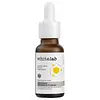What's inside
What's inside
 Key Ingredients
Key Ingredients

 Benefits
Benefits

 Concerns
Concerns

 Ingredients Side-by-side
Ingredients Side-by-side

Water
Skin ConditioningMethylpropanediol
SolventTranexamic Acid 3%
AstringentGlycerin
HumectantAlpha-Arbutin 2%
AntioxidantPanthenol
Skin ConditioningAllantoin
Skin ConditioningCentella Asiatica Extract
CleansingGlycyrrhiza Glabra Root Extract
BleachingSoluble Collagen
HumectantGlycine Soja Oil
EmollientSqualane
EmollientHydrogenated Lecithin
EmulsifyingHyaluronic Acid
HumectantHydrolyzed Hyaluronic Acid
HumectantHydrolyzed Sodium Hyaluronate
Skin ConditioningHydroxypropyltrimonium Hyaluronate
Potassium Hyaluronate
Skin ConditioningSodium Acetylated Hyaluronate
HumectantSodium Hyaluronate Crosspolymer
HumectantSodium Hyaluronate
HumectantTocopherol
AntioxidantAscorbyl Propyl Hyaluronate
Skin ConditioningDimethylsilanol Hyaluronate
HumectantPhenoxyethanol
PreservativeSaccharide Isomerate
HumectantPolyacrylate Crosspolymer-6
Emulsion StabilisingBis-PEG-12 Dimethicone
EmollientPropylene Glycol
HumectantPEG-40 Hydrogenated Castor Oil
EmulsifyingHydroxyphenoxy Propionic Acid
Skin ConditioningCitric Acid
BufferingDipotassium Glycyrrhizate
HumectantTetrasodium EDTA
Ethylhexylglycerin
Skin ConditioningPolyglyceryl-10 Oleate
Skin ConditioningSodium Citrate
BufferingSodium Benzoate
MaskingPentylene Glycol
Skin ConditioningPotassium Sorbate
PreservativeCI 17200
Cosmetic ColorantCI 77266
Cosmetic ColorantCI 18965
Cosmetic ColorantParfum
MaskingWater, Methylpropanediol, Tranexamic Acid 3%, Glycerin, Alpha-Arbutin 2%, Panthenol, Allantoin, Centella Asiatica Extract, Glycyrrhiza Glabra Root Extract, Soluble Collagen, Glycine Soja Oil, Squalane, Hydrogenated Lecithin, Hyaluronic Acid, Hydrolyzed Hyaluronic Acid, Hydrolyzed Sodium Hyaluronate, Hydroxypropyltrimonium Hyaluronate, Potassium Hyaluronate, Sodium Acetylated Hyaluronate, Sodium Hyaluronate Crosspolymer, Sodium Hyaluronate, Tocopherol, Ascorbyl Propyl Hyaluronate, Dimethylsilanol Hyaluronate, Phenoxyethanol, Saccharide Isomerate, Polyacrylate Crosspolymer-6, Bis-PEG-12 Dimethicone, Propylene Glycol, PEG-40 Hydrogenated Castor Oil, Hydroxyphenoxy Propionic Acid, Citric Acid, Dipotassium Glycyrrhizate, Tetrasodium EDTA, Ethylhexylglycerin, Polyglyceryl-10 Oleate, Sodium Citrate, Sodium Benzoate, Pentylene Glycol, Potassium Sorbate, CI 17200, CI 77266, CI 18965, Parfum
Ingredients Explained
These ingredients are found in both products.
Ingredients higher up in an ingredient list are typically present in a larger amount.
Panthenol is a common ingredient that helps hydrate and soothe the skin. It is found naturally in our skin and hair.
There are two forms of panthenol: D and L.
D-panthenol is also known as dexpanthenol. Most cosmetics use dexpanthenol or a mixture of D and L-panthenol.
Panthenol is famous due to its ability to go deeper into the skin's layers. Using this ingredient has numerous pros (and no cons):
Like hyaluronic acid, panthenol is a humectant. Humectants are able to bind and hold large amounts of water to keep skin hydrated.
This ingredient works well for wound healing. It works by increasing tissue in the wound and helps close open wounds.
Once oxidized, panthenol converts to pantothenic acid. Panthothenic acid is found in all living cells.
This ingredient is also referred to as pro-vitamin B5.
Learn more about PanthenolPhenoxyethanol is a preservative that has germicide, antimicrobial, and aromatic properties. Studies show that phenoxyethanol can prevent microbial growth. By itself, it has a scent that is similar to that of a rose.
It's often used in formulations along with Caprylyl Glycol to preserve the shelf life of products.
Propylene Glycol is an odorless, colorless liquid. As a humectant, it helps skin retain moisture. It also aids in delivering active ingredients.
Another role of this ingredient is preventing a product from melting or freezing. Propylene glycol also adds antimicrobrial properties to a product, elongating product lifespan.
This ingredient is considered an organic alcohol and commonly added into both cosmetics and foods.
Those with sensitive skin or conditions may develop a rash when using this ingredient.
Learn more about Propylene GlycolSodium Hyaluronate is hyaluronic acid's salt form. It is commonly derived from the sodium salt of hyaluronic acid.
Like hyaluronic acid, it is great at holding water and acts as a humectant. This makes it a great skin hydrating ingredient.
Sodium Hyaluronate is naturally occurring in our bodies and is mostly found in eye fluid and joints.
These are some other common types of Hyaluronic Acid:
Learn more about Sodium HyaluronateTranexamic Acid is best used for treating hyperpigmentation, discoloration, and melasma. It can also help build a stronger skin barrier.
Once applied, Tranexamic Acid starts decreasing inflammation from UV exposure. Tranexamic Acid also prevents our skin cells from meeting the pigment production cells.
Its brightening property makes it great at reducing the appearance of acne scars and marks.
Fun fact: Tranexamic Acid is also a medication used to reduce heavy bleeding.
This acid is derived from lysine, an amino acid.
Learn more about Tranexamic AcidWater. It's the most common cosmetic ingredient of all. You'll usually see it at the top of ingredient lists, meaning that it makes up the largest part of the product.
So why is it so popular? Water most often acts as a solvent - this means that it helps dissolve other ingredients into the formulation.
You'll also recognize water as that liquid we all need to stay alive. If you see this, drink a glass of water. Stay hydrated!
Learn more about Water